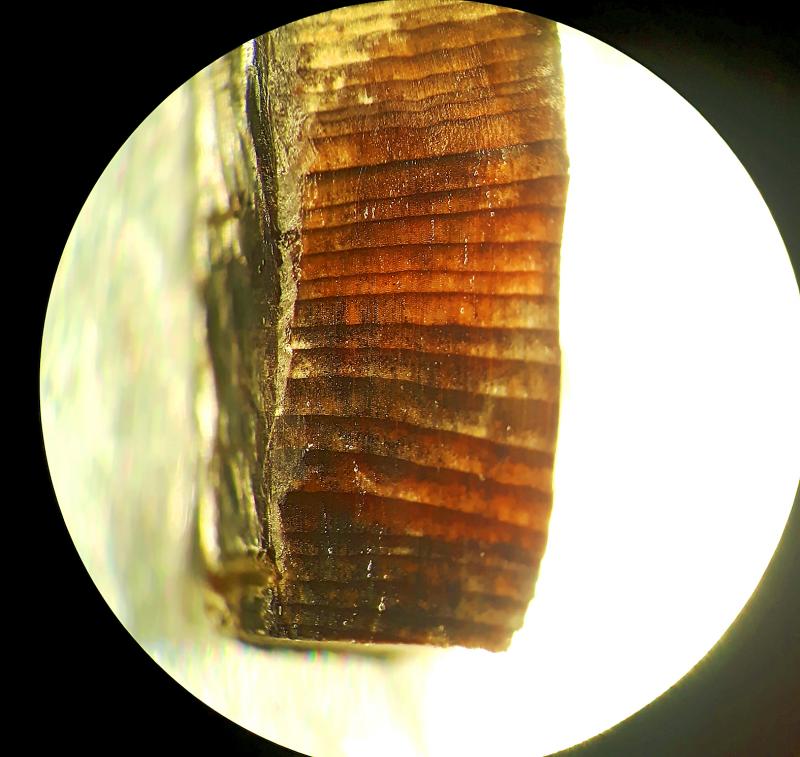Long before Christopher Columbus crossed the Atlantic, eight timber-framed buildings covered in sod stood on a terrace above a peat bog and stream at the northern tip of the Canadian island of Newfoundland, evidence that the Vikings had reached the New World first.
However, when precisely did the Vikings journeyed to establish the L’Anse aux Meadows settlement had remained unclear — until now.
Scientists on Wednesday said a new type of dating technique using a long-ago solar storm as a reference point revealed that the settlement was occupied in 1021, exactly one millennium ago and 471 years before the first voyage of Columbus. The technique was used on three pieces of wood cut for the settlement, all pointing to the same year.

Photo: Reuters
The Viking voyage represents multiple milestones for humankind. The settlement offers the earliest-known evidence of a transatlantic crossing. It also marks the place where the globe was finally encircled by humans, who thousands of years earlier had trekked into North America over a land bridge that once connected Siberia to Alaska.
“Much kudos should go to these northern Europeans for being the first human society to traverse the Atlantic,” said geoscientist Michael Dee of the University of Groningen in the Netherlands, who led the study published in the journal Nature.
The Vikings, or Norse people, were seafarers with Scandinavian homelands: Norway, Sweden and Denmark. They ventured through Europe, sometimes colonizing and other times trading or raiding. They possessed extraordinary boat-building and navigation skills, and established settlements on Iceland and Greenland.
“I think it is fair to describe the trip as both a voyage of discovery and a search for new sources of raw materials,” Dee said.
“Many archeologists believe the principal motivation for them seeking out these new territories was to uncover new sources of timber, in particular. It is generally believed they left from Greenland, where wood suitable for construction is extremely rare,” he added.
Their wooden vessels, called longboats, were propelled by sail and oars. One surviving example, called the Oseberg ship, is about 21.6m long.
The Viking Age is traditionally defined as 793 to 1066, presenting a wide range for the timing of the transatlantic crossing. Ordinary radiocarbon dating proved too imprecise to date L’Anse aux Meadows, which was discovered in 1960, although there was a general belief it was the 11th century.
The new dating method relies on the fact that solar storms produce a distinctive radiocarbon signal in a tree’s annual growth rings. It was known there was a significant solar storm — a burst of high-energy cosmic rays from the sun — in 992.
In all three pieces of wood examined, from three different trees, 29 growth rings were formed after the one that bore evidence of the solar storm, meaning the wood was cut in 1021, said University of Groningen archeologist Margot Kuitems, the study’s first author.
It was not local indigenous people who cut the wood, because there is evidence of metal blades, which they did not possess, Dee said.
The length of the occupation remains unclear, although it might have been a decade or less, and perhaps 100 Norse people were present at any given time, Dee said.
Their structures resembled Norse buildings on Greenland and Iceland.
Oral histories called the Icelandic Sagas depict a Viking presence in the Americas. Written down centuries later, they describe a leader named Leif Erikson and a settlement called Vinland, as well as violent and peaceful interactions with the local peoples, including capturing slaves.
The 1021 date roughly corresponds to the saga accounts, Dee said.
“Thus it begs the question, how much of the rest of the saga adventures are true?” he asked.

Kehinde Sanni spends his days smoothing out dents and repainting scratched bumpers in a modest autobody shop in Lagos. He has never left Nigeria, yet he speaks glowingly of Burkina Faso military leader Ibrahim Traore. “Nigeria needs someone like Ibrahim Traore of Burkina Faso. He is doing well for his country,” Sanni said. His admiration is shaped by a steady stream of viral videos, memes and social media posts — many misleading or outright false — portraying Traore as a fearless reformer who defied Western powers and reclaimed his country’s dignity. The Burkinabe strongman swept into power following a coup in September 2022

‘FRAGMENTING’: British politics have for a long time been dominated by the Labor Party and the Tories, but polls suggest that Reform now poses a significant challenge Hard-right upstarts Reform UK snatched a parliamentary seat from British Prime Minister Keir Starmer’s Labor Party yesterday in local elections that dealt a blow to the UK’s two establishment parties. Reform, led by anti-immigrant firebrand Nigel Farage, won the by-election in Runcorn and Helsby in northwest England by just six votes, as it picked up gains in other localities, including one mayoralty. The group’s strong showing continues momentum it built up at last year’s general election and appears to confirm a trend that the UK is entering an era of multi-party politics. “For the movement, for the party it’s a very, very big

ENTERTAINMENT: Rio officials have a history of organizing massive concerts on Copacabana Beach, with Madonna’s show drawing about 1.6 million fans last year Lady Gaga on Saturday night gave a free concert in front of 2 million fans who poured onto Copacabana Beach in Rio de Janeiro for the biggest show of her career. “Tonight, we’re making history... Thank you for making history with me,” Lady Gaga told a screaming crowd. The Mother Monster, as she is known, started the show at about 10:10pm local time with her 2011 song Bloody Mary. Cries of joy rose from the tightly packed fans who sang and danced shoulder-to-shoulder on the vast stretch of sand. Concert organizers said 2.1 million people attended the show. Lady Gaga

SUPPORT: The Australian prime minister promised to back Kyiv against Russia’s invasion, saying: ‘That’s my government’s position. It was yesterday. It still is’ Left-leaning Australian Prime Minister Anthony Albanese yesterday basked in his landslide election win, promising a “disciplined, orderly” government to confront cost-of-living pain and tariff turmoil. People clapped as the 62-year-old and his fiancee, Jodie Haydon, who visited his old inner Sydney haunt, Cafe Italia, surrounded by a crowd of jostling photographers and journalists. Albanese’s Labor Party is on course to win at least 83 seats in the 150-member parliament, partial results showed. Opposition leader Peter Dutton’s conservative Liberal-National coalition had just 38 seats, and other parties 12. Another 17 seats were still in doubt. “We will be a disciplined, orderly